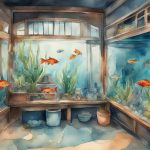When I first started my aquarium, I made some rookie mistakes that caused a lot of unnecessary stress for my fish and made it more challenging for me to maintain a healthy tank. I want to share with you the common mistakes that beginners often make when setting up an aquarium, so you can avoid them and create a thriving aquatic ecosystem from the start.
One of the biggest mistakes I made was starting with a too-small tank. I thought a smaller tank would be easier to handle, but I quickly learned that it’s the opposite. Smaller tanks have less water volume, which means that any changes in water parameters occur more rapidly and can have a greater impact on the health of your fish. It’s recommended that beginners start with a tank size of at least 20 gallons until they gain more experience.
Another mistake I made was adding fish too soon. When you first set up your tank, it takes time for the water to stabilize and for beneficial bacteria to establish. Adding fish too early can expose them to harmful substances in the water, as well as unbalanced water chemistry. It’s important to give the tank time to cycle and for the water parameters to stabilize before adding any fish. This process typically takes several weeks.
Overcrowding the tank and keeping incompatible fish together were two more mistakes I made. Overcrowding can lead to poor water quality, increased aggression among fish, and higher stress levels. It’s crucial to calculate the appropriate stocking levels for your tank based on the size, species, and compatibility of the fish. Keeping incompatible fish together can result in territorial disputes, aggression, and even injury or death.
Lastly, I want to emphasize the importance of proper filtration, understanding the nitrogen cycle, and regularly changing the water in your aquarium. Neglecting these aspects can lead to a buildup of harmful substances and poor water quality, which can negatively impact the health of your fish.
By being aware of these mistakes and taking the necessary precautions, you can ensure a successful and thriving aquarium setup right from the beginning. Don’t make the same errors I did. Take your time, do your research, and create a beautiful underwater world for your fish to enjoy.
Key Takeaways:
- Choose an appropriately sized tank to maintain stable water parameters.
- Allow the tank to cycle and stabilize before adding any fish.
- Avoid overcrowding and keep compatible fish together for a harmonious aquatic community.
- Ensure proper filtration, understand the nitrogen cycle, and regularly change the water.
- Take your time, do your research, and create a beautiful and thriving aquarium.
Starting with a Too-Small Tank
One of the most common mistakes when starting an aquarium is choosing a tank that is too small. While smaller tanks may be tempting for beginners, they can actually be more challenging to maintain. Smaller tanks have less water volume, which means that any changes in water parameters occur more rapidly and can have a greater impact on the health of your fish.
Imagine living in a tiny room. Any changes in temperature, humidity, or air quality would affect you much more quickly than if you were in a larger space. The same logic applies to fish in a too-small tank. Even a slight fluctuation in water temperature or pH can be detrimental to their health.
It is recommended that beginners start with a tank size of at least 20 gallons until they gain more experience. This size provides a more stable environment for the fish, allowing them to better adjust to any changes in water conditions. Additionally, a larger tank offers more swimming space, which is crucial for the well-being of many species.
“A bigger tank is like a safety net for your fish.”
Why is a larger tank more forgiving?
A larger tank provides a buffer against water quality issues. With more water volume, any toxins or pollutants are diluted, reducing their impact on the fish. It also allows for a more stable nitrogen cycle, which is essential for maintaining a healthy aquatic ecosystem.
When it comes to aquariums, bigger is often better. A larger tank provides a more stable environment and allows for a wider variety of fish species. It also gives you more leeway to make mistakes and learn from them without jeopardizing the well-being of your fish.
So, resist the temptation to start with a too-small tank. Give your fish the space they need to thrive and create a more forgiving environment in which they can flourish.
Adding Fish Too Soon

One of the most common mistakes that beginners make when starting an aquarium is adding fish too soon. It’s understandable to be excited about populating your tank, but patience is key to the long-term success of your aquatic ecosystem.
When you first set up your aquarium, it takes time for the water to stabilize and for beneficial bacteria to establish. This process, known as the nitrogen cycle, is essential for maintaining a healthy environment for your fish. Adding fish too early can disrupt this delicate balance and lead to various issues, including “new tank syndrome.”
New tank syndrome occurs when the water chemistry, particularly ammonia and nitrite levels, becomes toxic to fish. These harmful substances can cause stress, illness, and even death among your aquatic pets. To prevent this, it is crucial to give your tank time to cycle and for the water parameters to stabilize before introducing any fish. This process typically takes several weeks.
Furthermore, proper fish acclimation is essential for ensuring the well-being of your newcomers. Sudden changes in temperature, pH, or salinity can shock and stress fish, weakening their immune system and making them more susceptible to diseases. To acclimate your fish, float the bag containing them in the tank for around 15 minutes to help them adjust to the water temperature gradually. Then, open the bag and add water from the tank at regular intervals to allow the fish to acclimate to the new water parameters.
Benefits of Proper Fish Acclimation:
- Reduces stress: Fish experience less stress when introduced gradually to their new environment, increasing their chances of survival and long-term health.
- Enhances immune system: Proper acclimation helps fish adapt to the water parameters, strengthening their immune system and reducing the risk of diseases.
- Ensures compatibility: Acclimation allows fish to familiarize themselves with the existing tank inhabitants, making it easier to establish a harmonious aquatic community.
Remember, taking the time to properly cycle your tank and acclimate your fish not only promotes the well-being of your aquatic pets but also sets the foundation for a thriving and enjoyable aquarium experience.
| Common Mistakes When Adding Fish Too Soon | Consequences |
|---|---|
| Disrupting the nitrogen cycle | Unstable water chemistry, high ammonia and nitrite levels, poor water quality |
| Increased stress and illness | Weakened immune system, susceptibility to diseases |
| Compatibility issues | Fish aggression, territorial disputes, harm or death to tank inhabitants |
Overcrowding and Incompatible Fish
One of the most common mistakes that beginner aquarists make is overcrowding their tanks and keeping incompatible fish together. This can have detrimental effects on the overall health and well-being of your aquatic community.
Overcrowding can lead to poor water quality due to excessive waste production, which can result in increased stress levels and aggression among fish. It is crucial to calculate the appropriate stocking levels for your tank based on the size, species, and compatibility of the fish. By avoiding overcrowding, you can maintain a healthier and more balanced aquatic environment.
In addition to overcrowding, keeping incompatible fish together can also lead to territorial disputes, aggression, and even injury or death. It is essential to research each fish species and their specific needs before introducing them to your tank. Understanding their temperament, preferred water parameters, and compatibility with other fish will help you create a harmonious and thriving aquatic community.
By taking the time to plan your aquarium stocking and ensuring compatibility between fish species, you can avoid the issues caused by overcrowding and incompatible fish. This will contribute to a healthier and more enjoyable aquarium experience for both you and your aquatic inhabitants.








